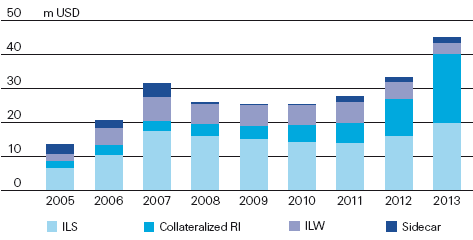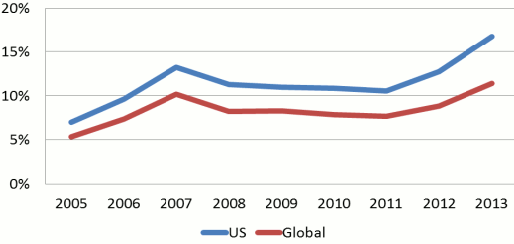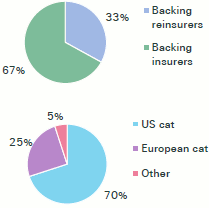Global reinsurer Swiss Re said today that it believes the amount of alternative reinsurance capital backed capacity in the global reinsurance market has increased by 80% since 2010 and is expected to continue growing, perhaps as fast as demand for catastrophe reinsurance increases.
Swiss Re published a new Sigma report today, a report containing an outlook to 2014/15 for the global reinsurance market, discussing a number of key trends and overall macroeconomic factors expected to impact on the reinsurance market. Alternative and third-party reinsurance capital of course features heavily in the report, as well as some thoughts on the catastrophe bond and insurance-linked securities market, which we covered earlier here.
The increasing interest from capital markets investors in the reinsurance space has led to heightened awareness of its impact on the market. With U.S. property catastrophe reinsurance heavily influenced by alternative capital and instruments such as catastrophe bonds, sidecars and industry loss warranties, as well as investors increasingly backing reinsurance contracts directly in a collateralized manner, the market has seen sharp growth.
Swiss Re shared some data on the size of the alternative reinsurance capital market, which it believes has reached $45 billion in size this year. The ILS and alternative reinsurance capital market has grown strongly since 2011, increasing by around 80% from $25 billion to the $45 billion it sits at today, according to Swiss Re.

Alternative reinsurance capacity by product and year (2005 - 2013) - Source: Swiss Re Capital Markets
Currently, Swiss Re says the $45 billion of alternative reinsurance capacity equates to around 11% of the global catastrophe excess of loss market and about 17% of the U.S. market. These levels are now higher than the percentages seen post-Katrina, demonstrating that the alternative reinsurance capital market has outpaced the growth of the overall reinsurance market.

Estimated market share of alternative reinsurance capital (excl. Retro capacity) - Source: Swiss Re
At a media event this morning, Martin Bisping, Swiss Re’s Head of Non-Life Risk Transfer, explained some of the trends being seen in the alternative reinsurance capital market.
Bisping explained that many of the dedicated catastrophe investment funds, once focused on catastrophe bonds and securitization as investments, are now entering the collateralized reinsurance space. Collateralized reinsurance is now the single fastest growing product in the alternative capital space, now around the size of the cat bond market.
Swiss Re notes in the report; “Money has been flowing into dedicated cat bond funds, but the supply of cat bonds has not kept pace with demand. Thus, the funds have placed the additional capacity into collateralized reinsurance contracts. Because cat bond spreads have come down substantially, funds have found it necessary to put capacity into more risky layers with higher premium income.”
Indemnity capacity has become widely accepted, as sponsors and cedents look to eliminate basis risk. As a result, Bisping said that the market in industry loss warranties (ILW’s) has shrunk significantly. Bisping also said that some sidecars have been scaled back, as a result of the softening across the catastrophe reinsurance market.
Alternative and third-party reinsurance capital remains focused on areas of the global reinsurance market where the margins are high and the barriers to entry are low, according to Swiss Re. By low barriers, Swiss Re means short-tailed, transparent and well modelled risks. It estimates that 70% of alternative capital is held in U.S. property catastrophe risks, mostly U.S. wind and earthquake, with another 30% in retrocession, but says it is not well established elsewhere.
There is, of course, a growing amount of alternative and third-party reinsurance capital which is not in U.S. prop cat or retro, but Swiss Re chooses not to refer to any of the initiatives seen in the market in 2013 and set to launch for 2014. Swiss Re is right that the bulk of the market remains focused on U.S. prop cat, but (as regular readers will be aware) there is an increasing desire among managers and investors to move further beyond these risks.

Alternative capacity by segment and peril - Source: Swiss Re
Swiss Re said that alternative capital struggles to expand beyond the low-barrier to entry lines as there is already ample reinsurance capacity available, traditional reinsurance can compete strongly on price, there is a lack of market loss indices in these regions and perils, risk models are seen as less consistent and reliable and that alternative capital cannot offer reinstatements.
At the same time, alternative capacity is impacting the reinsurance market, by increasing supply capacity is no longer scarce for peak risks, the catastrophe excess of loss business is becoming commoditized and it has been eroding the profit margin of once profitable lines of business for traditional reinsurers. This has all resulted in pressure on traditional reinsurance pricing and lower rates in many core peak catastrophe zones.
Most of the pressure from alternative reinsurance capital has been directed at what Swiss Re terms ‘commodity Bermuda-type reinsurers’ where alternative capital has been crowding out subscription markets. This has caused some of these reinsurers to look elsewhere, with a growing trend of diversifying into other lines such as casualty risks.
Again, it’s worth pointing out that there are a number of ILS and alternative capital initiatives looking seriously at casualty lines of business, so these markets may too find themselves coming increasingly under pressure from third-party sourced capital.
Swiss Re sees continued growth in demand for natural catastrophe reinsurance capacity in years to come. It expects demand to increase by 50% in mature markets and as much as 100% in high growth markets by 2020. The reason for this is continued growth in exposed economic values, growing middle class in emerging and high growth markets helping to increase insurance penetration and governments continuing to move catastrophe risks into the private sector.
Swiss Re said that it expects alternative reinsurance capital to grow in the U.S. by at least the same pace, perhaps faster, allowing it the chance to gain further market share in this market in particular. Low interest rates are likely to continue to stimulate investor interest in reinsurance as an asset class and alternative capital will likely continue to gain market share in reinsurance, although as a complementary product, Swiss Re said.
“Investors need well-modelled and transparent risks to invest in,” commented Martin Bisping. “We can expect funds to focus on established nat cat markets where the conditions are well understood – at the moment this means the US is the most attractive market.”
While alternative reinsurance capital is clearly increasing competition, Swiss Re believes large, diverse reinsurers (like itself) are largely immune from the effects. It sees small, subscription market, property catastrophe focused, reinsurers as the most likely to feel competitive threats.
For the larger reinsurers (like itself) Swiss Re believes the scale, staying power and client loyalty after large events, value added service model across all lines and regions, ability to offer tailored solutions with large capacity and financial strength as well as ability to use their capital multiple times without collateralizing risk, all put them in a strong position.
Swiss Re did note that it expects to continue taking advantage of the capital markets and alternative capital as well, by sharing peak risk exposures to better meet the increasing demand for catastrophe covers. It will likely also continue to use alternative capital for its own retrocessional needs, as and when appropriate.
Swiss Re says that while growth is as good as assured for the alternative reinsurance capital market, how fast that growth is remains to be seen. It does believe that further market share will be lost in the U.S. peak catastrophe risk markets, but does not expect the growth seen in the last two years to continue at that pace.
As ever, the opportunities for growth in alternative reinsurance capital, ILS and catastrophe bonds, will likely be in expanding the market, enabling investors to access new perils and regions, as well as continuing to focus on the peak catastrophe perils where the lower cost of capital makes ILS capacity more efficient.
You can access Swiss Re’s latest Sigma report, which also covers global macroeconomic conditons, non-life and life re/insurance market prospects and emerging market growth, via the press release here.
Read our earlier article on Swiss Re’s thoughts on the cat bond market: Catastrophe bond market reaches all-time high with 20% growth.
 View all of our Artemis Live video interviews and subscribe to our podcast.
View all of our Artemis Live video interviews and subscribe to our podcast.
All of our Artemis Live insurance-linked securities (ILS), catastrophe bonds and reinsurance video content and video interviews can be accessed online.
Our Artemis Live podcast can be subscribed to using the typical podcast services providers, including Apple, Google, Spotify and more.































